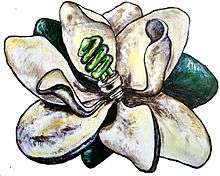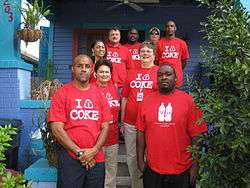Green Light New Orleans

Green Light New Orleans is a nonprofit organization based in New Orleans, Louisiana. The environmentally conscious organization works to reduce carbon emissions through the replacement of traditional, non-environmentally friendly bulbs with compact fluorescent lights (CFLs). Ultimately, the organization aims to remove all of the city’s incandescent lights and replace them with CFL lights.
History
New Orleans' low elevation and proximity to the Gulf of Mexico dubs it a high-risk flood zone, susceptible to the major effects of global warming. These risks became reality in summer of 2005, as levee failures compounded the devastation of Hurricane Katrina. Local New Orleans musician Andi Hoffmann and his band B-Goes founded Green Light New Orleans in response to this environmental disaster.
The band began by calculating the carbon output resultant of their tours and figured how many Compact Fluorescent Light bulbs (CFLs) would offset this output. For each European concert ticket attendees were asked to donate toward the cause. With overwhelming responses, the band returned to the United States and immediately established the organization.[1]
Mission
The city of New Orleans is greatly endangered by the negative repercussions of global warming. Global warming has been alleged to intensify the magnitude of tropical storms and hurricanes. Wasteful energy consumption is perhaps the largest contributor to global warming. Green Light strives to reduce energy consumption and mitigate carbon emissions through the installation of energy efficient bulbs. The ultimate objective of the organization is to remove all of the city's incandescent light bulbs and replace them with compact fluorescent lamps. What makes this program unique is that bulbs are supplied to homeowners and renters free of charge and are installed by the organization's volunteers. By having volunteers conduct installations, it is ensured the bulbs get put to immediate use. Therefore, beneficiary families immediately reduce their energy consumption and carbon emissions while also saving on utility bills. Within 4 years, Green Light New Orleans plans to replace all of the approximately 3 million incandescent bulbs in New Orleans residences with CFLs. GLNO has expanded outside of New Orleans. Currently, GLNO is also operating in Gramercy, Louisiana and has another branch in upstate South Carolina (Green Light South Carolina). The organization hopes to create national awareness of its positive impacts and that similar initiatives will be adopted in other U.S. cities.[2]
Compact fluorescent lights
CFL bulbs have revolutionized lighting to its most energy-efficient form. These miniature versions of full-sized fluorescents emit more light with less power; they use approximately one-third the energy of the average incandescent light bulb. Installation is no different from the average light bulb. They screw into the standard light socket to give off light similar to any average light bulb.
Incandescent versus Compact Fluorescent- Incandescents pass electricity through a small filament (wire) causing it to glow hot and produce lumens (light). Up to 90 percent of the energy used in this process is for heat, not light, production. This wasted energy is far offset by Compact Fluorescents as they process lumens through a gas charged tube; electricity passes through the tube to create a chemical reaction that yields light. This cooler source focuses almost all its energy on light production, itself.[3]
Use Less Energy: CFLs require 66 to 75 percent less electricity than the normal incandescent bulb.
Reduce Pollution and Energy Bill: Each reduced watt of power simultaneously reduces its complementary unit of pollution.
Last Longer: CFLs stick around for 8,000 to 10,000 more hours than the common incandescent. This survival rate doesn’t call for a bulb changin’ for up to 7 years!
Long Term Cost Benefits > Short Term Added Cost: Because CFLs are produced as a package, the bulb and the ballast, they inevitably cost more. In the short term CFLs are pricier, but in the long term they yield much lower replacement rates and energy costs (less watts of energy required in light production).
Volunteer program

Green Light New Orleans is able to operate through the selfless efforts of its volunteers. The organization welcomes volunteers from out-of-state and from within the community. The organization currently solicits volunteers from social activist groups such as AmeriCorps, universities, corporations, and individuals interested in being a part of green program.
Involvement with AmeriCorps*NCCCs, AmeriCorps*Delta Direct, and AmeriCorps*VISTA
AmeriCorps Being that Green Light is a young and very small non-profit, the organization utilizes the dedication of AmeriCorps volunteers for its daily operations, project coordination, and developmental ventures. There are three branches of AmeriCorps - State and National Delta Direct service members, NCCC (the National Civilian Community Corps), and VISTA (Volunteers in Service to America)- and Green Light depends on volunteers from all three branches.[4]
Rebuilding and education
Green Light educates New Orleanians with the environmental awareness needed to combat the effects of global warming; this effort not only rebuilds, but also revitalizes New Orleans through efficiency and sustainability. The free service reduces utility costs and carbon emissions simultaneously by switching low and fixed income households to energy efficient lighting. Volunteers visit the homes of New Orleans' residents and, together, they install CFLs. Green Light's strategy founds a connection between volunteers and residents that immediately puts the bulbs to use and the community dynamic into reformation.
Fundraising
The program is supported through private donations, sponsors, and corporate grants.
Buy Green, Give Green
See also
References
- ↑ http://www.greenlightneworleans.org/greenabout.html
- ↑ http://www.greenlightneworleans.org/greenmission.html
- ↑ http://cflbulbs.com/compact-fluorescent-lights.php
- ↑ Green Light New Orleans Americorp Volunteer April, 2010
External links
- Green Light New Orleans
- http://blog.nola.com/karengist/2007/06/seeing_the_light_musician_want.html
- http://www.neworleansmagazine.com/a/news/seeing-green-3472/hoffman.html
- http://www.ornl.gov